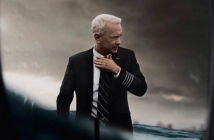
Editor’s Notes: Sully opens in wide theatrical release today, September 9th.
. . . turning a remarkable achievement (the forced landing on the Hudson River, all lives saved) into an unremarkable film (Sully: The Movie).
As portrayed by two-time Oscar winner Tom Hanks, the Sully we meet in the first scenes suffers from a particular brand of Hollywoodized survivor’s guilt and/or PTSD (later he’s overwhelmed by his newfound celebrity status amplified by a dose of Imposter’s Syndrome). He might have piloted a commercial jetliner, an Airbus A320, filled with 155 souls to safety after an unexpected bird strike rendered the Airbus A320’s engines inoperative, a remarkable, unique achievement in the annals of forced airplane landings, but Sully can’t get a good night’s sleep. He wakes up in the proverbial cold sweat, wracked by the overwhelming sense that maybe, just maybe, he erred, a suspicion that becomes concrete when the seemingly routine investigation by the National Transportation Safety Board (NTSB) turns into the equivalent of a trial, forcing Sully and his co-pilot, Jeff Stiles (Aaron Eckhart), to defend every single decision they made over the course of 208 seconds (from bird strike to forced water landing). Their skepticism magnify Sully’s own doubts about whether he made the right decision or attempt a landing at the LaGuardia Airport in New York or the Teterboro Airport in New Jersey.

Working from Todd Komarnicki’s loose adaptation of Sully’s book, “Highest Duty,” Eastwood jumps around in time, mixing flashbacks of the crash, pre-crash events, and Sully’s early experiences as a pilot, with the increasingly antagonistic NTSB hearings and strained phone calls between Sully and his wife, Lorraine (Laura Linney). While Sully understandably worries about whether he did the “right thing” and whether the NTSB will ultimately agree with his decision to ditch the jetliner in the Hudson River, Lorraine worries about his pension (gone if the NTSB rules against him), his side business as a safety expert/consultant (also gone if the NTSB rules Sully erred by not trying to land at LaGuardia or Teterboro), and whether they’ll be able to pay their mortgage. Her concerns, while real (within the film), make her seem petty, even small-minded at times.
Eastwood gives us a trio of hostile, unsympathetic government bureaucrats who undermine Sully at every opportunity, repeatedly insisting he could have landed the jetliner at a nearby airport.
It’s particularly telling that Sully and Lorraine never share the same space together, not even in the final scene (Eastwood closes the film with the NTSB’s decision and immediate aftermath). Eastwood saves the Sully-Lorraine reunion for the obligatory post-credits meet-and-greet with the real Sully, his wife, the crew, and the passengers, unintentional representatives of a white, minority-free America (just like God and Clint Eastwood intended, apparently). With the reel Lorraine relegated to background filler (a sad, unfortunate waste of Linney’s talents), Sully fixates on the professional bond between Sully and Skiles. United by their experience, they individually and collectively function as the epitome of professionalism. They spent years (Sully more than Skiles) preparing for the unforeseen, the unhoped-for potential tragedy and those experiences – decisions milliseconds in the making (i.e., “gut instinct”) – proved to be correct, saving 155 souls (crew and passengers) in the process.
As much as the real-life Sully should be celebrated (and he should, unreservedly), Eastwood never makes a compelling case as to why Sully and the forced landing of US Airways Flight 1549 deserved a big-screen, fictionalized recreation where a documentary could have served the same purpose. Making the NTSB, a government agency dedicated not just to investigating accidents, but offering safety recommendations as well – it’s equally telling that Eastwood and Komarnicki compress the NTSB’s painstakingly meticulous, fifteen-month investigation into a few days (the better to increase bogus dramatic stakes) – into the stand-in villain apparently every Oscar-bait season entry needs to resonate with general moviegoers and the Academy, doesn’t just feel like a misguided choice, but an intentionally political one (i.e., anti-government, anti-government agency). Instead, Eastwood gives us a trio of hostile, unsympathetic government bureaucrats who undermine Sully at every opportunity, repeatedly insisting he could have landed the jetliner at a nearby airport.
Sully’s third act culminates with several cockpit simulations of Flight 1549 at a public hearing. Missing from the simulations? The “human factor,” of course, but that’s something that the NTSB misses due to a combination of shortsightedness and malevolence toward Sully and Skiles. Given Eastwood’s right-leaning politics, it’s hard not to read an anti-government message into Sully (celebrate heroes for their heroism, corporations should be left free, unencumbered by government interference, regulations, or safety-related investigations). Intentional or not (i.e., conflict is a necessary prerequisite for drama), the result remains unchanged: Sully (the film) never rises above writer- and director-imposed limitations. It embraces those limitations unapologetically, turning a remarkable story(the forced landing on the Hudson River, all lives saved) into an unremarkable film (Sully: The Movie).
As much as the real-life Sully should be celebrated (and he should, unreservedly), Eastwood never makes a compelling case as to why Sully and the forced landing of US Airways Flight 1549 deserved a big-screen, fictionalized recreation where a documentary could have served the same purpose.



